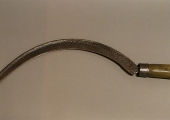The Museum Collection: Farming and horticulture
.
Bradford on Avon Museum, Wiltshire
.
There were once scores of farms of all sizes in the area around Bradford. Each one would have possessed numerous hand implements and machines relating to particular activities- digging and ploughing, keeping up ditches, hedges and dry-stone walls, animal husbandry, sheep-shearing, harvesting, the dairy with its milking, butter-making and cheese-making work. The area also supported numerous market gardens and nurseries and a large number of allotment gardens.
Click on the thumbnail pictures to get a bigger view
.
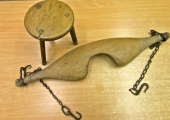 The milking stool is low, to get down to the level of a cow’s udders and is three-legged, because that is more stable on uneven ground than four. The yoke -for carrying two buckets from the shoulders- is carved from ash wood with chains and hooks that were made by a blacksmith, possibly Lailey in Bridge Street. Popular imagination associates both articles with milkmaids, but these were used by Ernie Chard, the farmer at Barton Farm until the 1960s.
The milking stool is low, to get down to the level of a cow’s udders and is three-legged, because that is more stable on uneven ground than four. The yoke -for carrying two buckets from the shoulders- is carved from ash wood with chains and hooks that were made by a blacksmith, possibly Lailey in Bridge Street. Popular imagination associates both articles with milkmaids, but these were used by Ernie Chard, the farmer at Barton Farm until the 1960s.
.
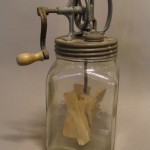 A hand butter churn (left) that holds four quarts -in other words, one gallon (4.55 litres). Butter is made by churning cream until the fat separates from the liquid and clumps together. There are many sorts of churn; this has wooden paddles turned by a handle through gearing. The glass jar allows the operator to see precisely when the butter is ready. This is one of three that were used by Muriel Pearce, who once kept a few cows by the river at Belcombe, Bradford.
A hand butter churn (left) that holds four quarts -in other words, one gallon (4.55 litres). Butter is made by churning cream until the fat separates from the liquid and clumps together. There are many sorts of churn; this has wooden paddles turned by a handle through gearing. The glass jar allows the operator to see precisely when the butter is ready. This is one of three that were used by Muriel Pearce, who once kept a few cows by the river at Belcombe, Bradford.
.
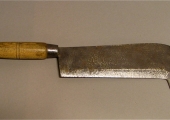 A billhook was largely used for hedging and coppicing. This is of a pattern known as a Southern Counties or Devon billhook. It has a ten-inch straight blade of steel with a hook at the end and a handle made of ash. It is ideal for splitting hazel for making hurdles.
A billhook was largely used for hedging and coppicing. This is of a pattern known as a Southern Counties or Devon billhook. It has a ten-inch straight blade of steel with a hook at the end and a handle made of ash. It is ideal for splitting hazel for making hurdles.
.
.
The sickle has a narrow, thin curved blade and was principally used for cutting corn, but could be for cutting back any soft plants. Around here it is known as a reaping hook, usually shortened to riphook.
.
.
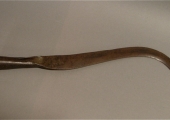 The slasher, with its narrow S-shaped blade is used in clearing woody patches, such as brush thickets and can be used in hedging. It would have had a long handle of ash wood, but this has rotted away.
The slasher, with its narrow S-shaped blade is used in clearing woody patches, such as brush thickets and can be used in hedging. It would have had a long handle of ash wood, but this has rotted away.
.
.
.
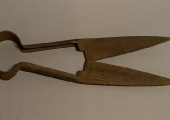 Hand shears had numerous uses around the farm, market garden, industry and home. In agriculture, they might have been used for shearing the wool from sheep before the introduction of powered clippers.
Hand shears had numerous uses around the farm, market garden, industry and home. In agriculture, they might have been used for shearing the wool from sheep before the introduction of powered clippers.
.
.
.
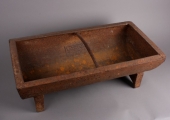 A cast iron pig-feeding trough that was made at the old foundry in Trowbridge Road that was run by Berkley Uncles & Sons. The firm’s name plate has been cast into the metal, so the pigs would have seen it as they ate their swill at Church Farm in Atworth.
A cast iron pig-feeding trough that was made at the old foundry in Trowbridge Road that was run by Berkley Uncles & Sons. The firm’s name plate has been cast into the metal, so the pigs would have seen it as they ate their swill at Church Farm in Atworth.
.
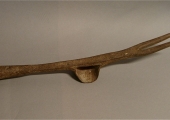 The dock lifter is a useful tool for extracting large weeds with deep tap-roots like docks and thistles. The forks are dug into the soil at the base of the plant, then the curved back piece provides a fulcrum to lever the root out with a long ash handle. Farmers in the past would routinely carry one while walking around the ground, but the weeds tend to be left in or sprayed today.
The dock lifter is a useful tool for extracting large weeds with deep tap-roots like docks and thistles. The forks are dug into the soil at the base of the plant, then the curved back piece provides a fulcrum to lever the root out with a long ash handle. Farmers in the past would routinely carry one while walking around the ground, but the weeds tend to be left in or sprayed today.
.
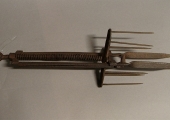 The mole trap is a vicious device. The two big spikes were inserted into the ground on each side of the mole’s run, then with a foot on the base the other spikes were drawn up against the spring with the loop at the top and locked with a bar. The unfortunate victim unlocked the bar and the spikes when it moved a trigger in the run.
The mole trap is a vicious device. The two big spikes were inserted into the ground on each side of the mole’s run, then with a foot on the base the other spikes were drawn up against the spring with the loop at the top and locked with a bar. The unfortunate victim unlocked the bar and the spikes when it moved a trigger in the run.
.
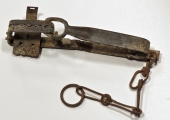 Another nasty implement is this gin trap, which was used to catch an animal -vermin like a fox, or a food animal such as a rabbit. The chain was to anchor it into the ground. Gin traps have illegal since 1958. The “gin” part of the name derives from engine, a word that was formerly used for any mechanical device.
Another nasty implement is this gin trap, which was used to catch an animal -vermin like a fox, or a food animal such as a rabbit. The chain was to anchor it into the ground. Gin traps have illegal since 1958. The “gin” part of the name derives from engine, a word that was formerly used for any mechanical device.
.


